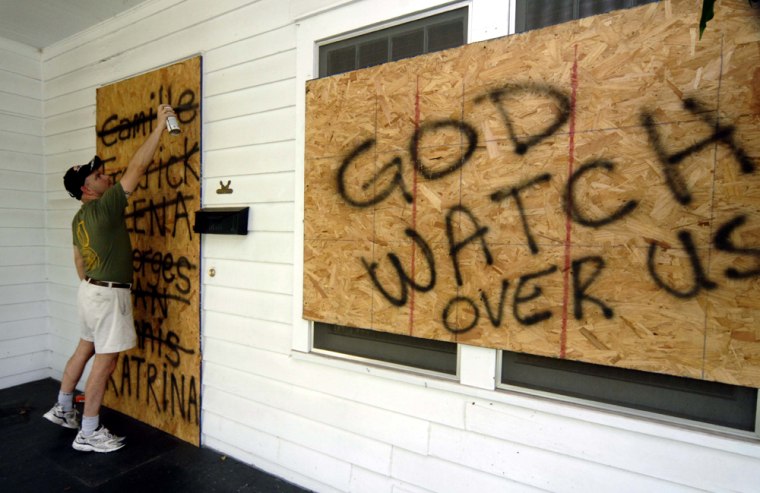Mississippi’s Gulf Coast rapidly emptied of even storm-hardened locals Sunday, leaving mostly deserted beaches, darkened casinos and boarded-up homes to face Hurricane Katrina.
“This is not a coastal storm,” Gov. Haley Barbour warned. “We are talking about a 30 foot wall of water. Take this seriously.”
Strong wind gusts already pounded coastal areas Sunday afternoon and conditions were expected to rapidly deteriorate. Evacuation orders were posted all along the coastal area.
Residents who remembered Hurricane Camille wanted no part of a repeat. Camille, one of only three Category 5 hurricanes to hit the U.S. mainland since 1900, struck on the night of Aug. 17, 1969.
Winds of more than 200 mph flattened buildings and tossed boats across a beach-side highway that night. The tide surged to 24 feet, sending water over rooftops. In Mississippi alone, 131 people were killed.
“I expect maybe the frame of my building to be left,” said Ron Roland, who owns a harbor shop at the Gulfport Marina. “I was here for Camille. It was unbelievable. It looked like an atom bomb went off around here.”
Before leaving, some locals walked along the shore to get a last glimpse of their beloved beaches.
“I just came down to see what it’s like before — because I know what it’s going to look like after,” said Joe Moffett, 34. Nearby, a group of children frolicked in the choppy sea, enjoying some last moments in the warm Gulf before Katrina hits.
Alabama: All day curfew
MOBILE, Ala. — Gov. Bob Riley declared a state of emergency, and schools, bus lines and many businesses shut down in Mobile. Across the Mobile Bay, Baldwin County officials also braced for a storm surge and flooding at Gulf resorts that are still recovering from Hurricane Ivan less than a year ago.
The beachfront area of Gulf Shores and Orange Beach were under evacuation orders, and a line of heavy traffic, including boats being towed, headed north Sunday.
Gulf Shores Police Chief Arthur Bourne said the resort city would be under curfew all day Monday. The city was expected to be hit by winds of at least 80 mph through most of the day.
As Katrina loomed, Katie Newton Collins and her husband Jake boarded up the family home on Alabama Pass in Orange Beach before heading toward their home in Birmingham.
“When Ivan came through we said goodbye, and now this. It just keeps coming,” Katie Collins said.
Traffic moved at a crawl along Alabama highways Sunday as the rain started pelting evacuees fleeing east and north.
By nightfall water began crossing the road at Fort Morgan and pooling beneath homes on stilts. Emergency officials warned the hurricane could bring historic flood levels to Mobile’s downtown riverfront and leave bayou and beachfront roads well under water.
The traffic was almost bumper to bumper as far north as Greenville by late afternoon on Interstate 65, and on Interstate 10 from the Mississippi line to the Florida border, the top speed was 25 mph in some area as residents fled. State Trooper Cpl. Spencer Collier anticipated the congestion would last through the night.
Texas: Surfers rescued
SURFSIDE BEACH, Texas — Thirteen surfers were pulled to safety off Quintana Beach on the Gulf of Mexico after becoming fatigued in 15-foot seas created by Katrina, the U.S. Coast Guard said.
Troy Davis, a petty officer with the Coast Guard, said rip tides were strong Sunday. Most of the rescues occurred 400 to 500 yards offshore.
“That rip tide is real bad,” said surfer Gary Blanchard. “It took me almost an hour to get in.”
Surfside Beach closed the Surfside jetties, used by many surfers as a launching point, Sunday evening. Surfside Beach is about 60 miles south of Houston.
In Austin, meanwhile, Gov. Rick Perry sent a 90-member urban search and rescue team to Louisiana to help out as the hurricane hits and in its aftermath.
Texas Task Force One, part of the 28-team national urban search and rescue system under the Federal Emergency Management Agency, is trained and equipped to locate and rescue people trapped by flooding and collapsed structures.
Up to 200 members of the Texas State Guard also could be sent to southeast and eastern Texas to set up and run shelters for evacuees fleeing Louisiana.
By Sunday, hundreds of Louisiana residents fleeing from Hurricane Katrina filled up shelters and hotels in southeast Texas.
Janie Johnson, service delivery manager with the American Red Cross chapter in Orange, described the steady flow of arrivals Sunday night as a “river of headlights.”
“They’re tired and they’ve been on the road all day and they don’t know what they’re going home to,” she said.
More than 90 people had settled in at the First Baptist Church, where activities were set up for children. Once the shelter total reached 100, the First Presbyterian Church was set to open.
Local veterinarian clinics and city animal control took care of the pets that residents had brought
Hotels also were filling up as evacuees headed west.
“We are 100 percent full,” said Agatha Boniface, assistant general manager of a Hampton Inn along Interstate 10, which connects New Orleans and Houston. She said they’ve been booked solid since Thursday, mostly with evacuees.
Pennsylvania: Eyes on dams
PITTSBURGH — The remnants of Hurricane Katrina could also spell trouble for dams hundreds of miles away.
The Pennsylvania Department of Environmental Protection is monitoring dams closely, fearing Katrina and its remnants could waterlog the region as the storm moves over land.
“We are concerned going into every hurricane season, and we are particularly concerned this year because of the forecast for a larger than normal number of hurricanes,” said Dennis Dickey, chief of the DEP’s Division of Dam Safety.
Remnants of Hurricane Ivan caused massive flooding in western Pennsylvania last fall.
